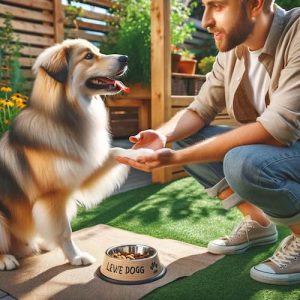
| Table of Contents | ||
| ● Introduction | ||
| ● Understanding Food Aggression | ||
| ● Recognizing Signs of Food Aggression | ||
| ● Management Strategies | ||
| ● Seeking Professional Assistance | ||
| ● Conclusion: Nurturing a Harmonious Relationship |
Introduction
In our journey as pet owners, it’s essential to understand and address certain behaviors that our furry companions may exhibit, such as dog food aggression. This behavior, often misunderstood, occurs when dogs become overly protective of their food, displaying behaviors ranging from mild growling to severe aggression. But fear not, as with the right strategies, we can create a harmonious environment for both our pets and ourselves. In this guide, we’ll explore the nature of food aggression, its impact on multi-pet households, and practical management techniques. By recognizing the signs and implementing appropriate strategies, we can ensure the safety and well-being of our beloved
pets while fostering a deeper bond with them.
Definition of Food Aggression
Food aggression, a behavior often seen in dogs like Miniature Pinschers, is when a dog gets protective of their food. It can range from growling to even biting. Pet owners need to understand that this behavior, called resource guarding, is natural for dogs. In multi-pet households, it’s important to control this behavior to keep everyone safe and happy. By learning about food
hostility and using behavior modification techniques, pet owners can help their dogs feel more secure and improve their emotional health. Sometimes, professional assistance might be needed to address food aggression effectively.
Significance for Pet Owners:
Understanding the significance of food hostility for pet owners is crucial in creating a safe and harmonious environment for all furry family members. In multi-pet households, conflicts over food can arise, especially among breeds like Miniature Pinschers known for their protective instincts. By recognizing the signs of resource protection and implementing effective management techniques, pet owners can promote emotional health and reduce stress-related behaviors in their dogs. Utilizing behavior modification techniques and seeking professional assistance when needed are essential steps in addressing food aggression and ensuring the well-being of both pets and their human caregivers.
Read: Top 10 Best Rated Dog Food Brands
Understanding Food Aggression:
Understanding food hostility is all about recognizing why some dogs become protective or aggressive around their food. It’s important to know that this behavior is natural for dogs, but it can cause problems at home. When dogs feel like they need to guard their food, it can lead to fights, especially in homes with more than one pet. By learning about food aggression, pet owners can take steps to keep their pets safe and happy during mealtime.
A Nature of Food Hostility:
Food hostility in dogs refers to their instinctual behavior of guarding or protecting their food. This behavior can range from mild signs like growling to more severe actions such as biting. It’s important for pet owners to understand that this behavior is natural for dogs and stems from their survival instincts. Dogs, including breeds like Miniature Pinschers, may exhibit food hostility, especially in multi-pet households where there’s competition for resources. By recognizing and addressing this behavior early on, pet owners can ensure a safer and more peaceful mealtime environment for their furry companions.
Factors Contributing to Food Hostility:
Understanding why dogs become hostile around food is essential for pet owners. Environmental triggers, such as feeling crowded during meal times or the presence of other animals, can make dogs feel threatened and protective over their food. Additionally, past negative experiences, like punishment for natural guarding behaviors, can contribute to food aggression. By
recognizing these factors, pet owners can take proactive steps to create a calm and stress-free dining environment for their dogs, reducing the likelihood of food-related conflicts.
Resource Guarding:
Resource protection occurs when dogs become overly protective of their food or other valued possessions. It’s like when a dog
doesn’t want anyone to come near its food bowl or toys because it thinks they might take them away. This behavior is natural for dogs, but it can cause problems in a home with other pets or people. Understanding resource guarding is important for pet owners so they can keep their pets safe and happy. By learning how to manage resource protection, pet owners can create a peaceful environment where all pets feel secure and respected.
Search: Best Selling Calming Dog Chews

Breed Predisposition:
Understanding how different dog breeds may have a natural tendency towards food aggression is important for pet owners.
Some breeds, such as Miniature Pinschers, might be more prone to this behavior due to their genetic makeup and historical background. However, it’s essential to remember that individual personality, past experiences, and the environment also play significant roles in the development of food hostility Being aware of breed predispositions allows pet owners to take proactive
steps in preventing and managing food-related conflicts, creating a safer and happier living environment for their canine companions.
Impact On Multi-pet-Households:
Food aggression can significantly affect households with more than one pet. In these settings, competition for resources,
including food, can intensify tensions among pets. When one pet displays food aggression, it may trigger defensive or aggressive behaviors in others, leading to conflicts and stress. Understanding and addressing food hostility in multi-pet households is crucial for maintaining a peaceful environment. Implementing management strategies, such as separate feeding areas and supervised mealtimes, can help alleviate competition and reduce the risk of confrontations over food. Additionally, promoting positive interactions and ensuring each pet feels secure during meal times can foster harmony among furry companions.
Recognition Signs of Food Hostility:
It’s important for pet owner to recognize signs of food hostility in their dogs. These signs can include growling, snapping, or showing stiff body language when approached while eating. Some dogs may eat very quickly or become overly protective of their food bowl. These behaviors indicate that the dog feels threatened or anxious about its food and may escalate to aggression if
not addressed. By understanding these signs, pet owners can take proactive steps to manage food aggression and create a safer environment for their pets and family members.
Behavioural Indicators:
Understanding your dog’s behavior is key to addressing food aggression. Watch for signs like stiffening, freezing, or intense staring while your dog eats. These behaviors signal that your dog may feel threatened and is ready to protect its food. Other indicators include growling, snapping, or even biting if someone gets too close. By being aware of these signs, you can take
proactive steps to manage your dog’s behavior and create a safe eating environment for everyone.
Environmental Triggers:
Environmental triggers play a significant role in influencing a dog’s behavior, especially when it comes to food aggression. Factors such as feeling crowded or threatened during meal times can cause dogs to become defensive over their food. In multi-pet households, the presence of other animals during feeding sessions can also trigger guarding behaviors. Creating a calm and stress-free dining environment, free from competition and distractions, can help minimize these triggers and promote peaceful meal times for all pets.
Management Strategies:
Implementing management strategies is key to addressing dog food hostility safely and effectively. Pet owners can create a calm and controlled feeding environment by feeding dogs separately in multi-pet households. This helps minimize competition and reduces the likelihood of conflicts over food resources. Additionally, using positive reinforcement techniques such as
rewarding calm behavior around food can encourage a peaceful mealtime atmosphere. Consistency and patience are essential when applying these strategies to ensure a positive and stress-free dining experience for both pets and their owners.
Emotional Health Consideration:
Taking care of your dog’s emotional health is an important aspect when dealing with food aggression. Dogs may feel anxious or stressed when they feel the need to guard their food. By understanding and addressing these emotions, pet owners can create a more calm and secure environment for their furry friends. This can involve using positive reinforcement techniques to help dogs feel safe around food and reducing any triggers that may cause them to feel threatened. Additionally, providing plenty of love, attention, and reassurance can go a long way in supporting your dog’s emotional well-being.
Environmental Modifications:
Making changes to your pet’s surroundings can help reduce food aggression and create a calmer mealtime environment. This could include feeding pets in separate areas to avoid competition and stress during meals. By providing each pet with its own space, you can minimize conflicts and promote a peaceful coexistence. Additionally, ensuring that mealtime areas are quiet and free from distractions can further help alleviate tension during feeding times. These environmental modifications play a key role in managing food aggression and fostering a harmonious living environment for all pets in the household.
Seeking of Professional Assistance:
Seeking professional help from a dog trainer or behaviorist can be a great idea. These experts have the skills and experience to work with your dog and teach you how to manage food aggression safely. Don’t worry; with the right help, you and your furry friend can overcome this challenge together.
When to consider professional help:
If your dog shows signs of food aggression, like growling or snapping when near their food, it’s important to consider professional help. Seeking assistance from a trained expert can help address this behavior safely and effectively. Professional trainers or behaviorists can provide guidance on how to manage food hostility and implement positive training techniques. Don’t wait until the situation escalates—seeking professional help early can prevent potential conflicts and ensure a happier, safer environment for both you and your furry friend.
Conclusion:
Understanding and addressing dog food aggression is essential for pet owners to ensure a harmonious relationship with their furry companions. By recognizing the signs of food aggression and implementing effective strategies, such as training and seeking professional help when needed, pet owners can create a safe and peaceful mealtime environment for their dogs. Remember, patience, consistency, and positive reinforcement are key in addressing this behavior. With dedication and the right approach, pet owners can help their dogs overcome food aggression and foster a trusting and loving bond for years to come
